About me and why I created this physics website.
Apophis Warning
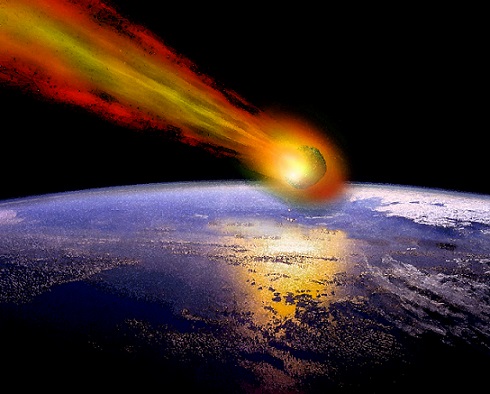
On April 13, 2029, the large asteroid Apophis will approach Earth. The very close approach that it is predicted to make represents a significant danger.
The danger becomes evident when examining asteroid data from the database, NEO Earth Close Approaches (https://cneos.jpl.nasa.gov/ca/). The chart below shows asteroid data from this database, filtered to include only asteroids up to the year 2075 and within a distance from Earth of 400,000 km (distance to Moon) or less at their closest flyby. The result was 364 asteroids under consideration at the time I retrieved the data (March 19, 2023). Each dot on the chart represents an asteroid with the corresponding minimum distance to Earth on the horizontal axis, and minimum asteroid diameter on the vertical axis.
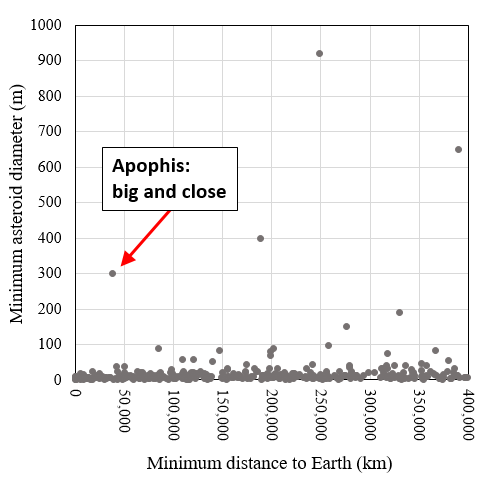
As you can see, one asteroid in particular really stands out. This is Apophis (99942 Apophis, as it is sometimes called). It is by far the most dangerous given its size and predicted distance to Earth.
It is predicted to arrive at a distance of 32,000 km from Earth. Right now scientists are certain that Apophis won't impact the Earth on April 13, 2029. But such certainty is misplaced given that the last time orbital measurements were made on Apophis was in March 2021, during its last close flyby. The next flyby will be on April 13, 2029, which means there will be an intel gap of eight years on the asteroid's orbital movements. In that time something can happen to cause its orbit to deviate from what is predicted. It could be some gravitational influence that is unknown to us, large enough to perturb the motion of Apophis causing an impact with Earth. Apophis could also collide with another asteroid changing its trajectory in a dangerous way. Apophis can also start releasing gases (a process called outgassing) at some point, perhaps triggered by solar heating or by impact with small asteroids. Outgassing is another possible effect on trajectory. This effect is not necessarily negligible.
The surface composition of Apophis is probably chondrite (https://arxiv.org/abs/1803.05375), which is a material known to produce outgassing (https://www.sciencedirect.com/science/article/abs/pii/S0019103506003174). Outgassing produces a tiny amount of thrust which can significantly alter the trajectory of the asteroid over a period of years. In the case of the comet Oumuamua, its trajectory was 100,000 km ahead of where it would be if only gravity dictated its motion. This was due to outgassing (https://astronomy.com/magazine/2020/02/our-first-interstellar-visitor).
Here's an excerpt from the paper, "Is the physics within the Solar system really understood?"
Comets usually come back a few days before they are expected when applying ordinary equations of motion. The delay usually is assigned to the outgassing of these objects. In fact, the delay is used for an estimate of the strength of this outgassing. https://www.uv.es/jfgf/Pioneer/0604052.pdf
Outgassing on an asteroid could produce a similar time discrepancy, causing it to end up in a position much different from what is expected.
Here's an excerpt from a Forbes article:
Even asteroids contain substantial amounts of volatile compounds, and can often develop tails when they approach near the Sun. A small amount of outgassing can substantially change an asteroid's or comet's trajectory over long timescales. https://www.forbes.com/sites/startswithabang/2021/03/29/why-is-it-so-hard-to-rule-out-future-asteroid-and-comet-strikes-on-earth/
Here are other excerpts from a Forbes article:
Asteroid Apophis has been measured many times over the timespan of multiple years quite precisely, leading scientists to determine its orbit to a remarkable precision. Of course, additional effects, such as offgassing or gravitational encounters, have the potential to alter that orbit beyond mere Keplerian effects.
Finally, solar heating will lead to volatile offgassing, accelerating asteroids with shape irregularities and rotational motions. https://www.forbes.com/sites/startswithabang/2020/11/16/what-are-the-real-odds-of-doomsday-asteroid-apophis-striking-earth-in-2068/
Accurately accounting for the effect of outgassing on the orbit of a comet or asteroid is difficult because it requires precise information of the body surface. As far as I know, outgassing on Apophis is not known and has not been accounted for. But at the same time, it is doubtful that it could be accurately accounted for.
From the article, "Cometary Orbit Determination and Nongravitational Forces":
The accuracies of the orbits and ephemerides for active comets are most often limited by imperfectly modeled rocket-like accelerations experienced by active comets as a result of the outgassing cometary nucleus near perihelion. https://www.lpi.usra.edu/books/CometsII/7009.pdf
The point I'm making is that there can be influences, from outgassing or otherwise, that affect the trajectory of Apophis so that the predicted near miss in 2029 becomes a direct hit.
Statement from NASA:
These images represent radar observations of asteroid 99942 Apophis on March 8, 9, and 10, 2021, as it made its last close approach before its 2029 Earth encounter that will see the object pass our planet by less than 20,000 miles (32,000 kilometers). https://www.jpl.nasa.gov/images/pia24168-radar-observations-of-asteroid-99942-apophis
This implies that the trajectory of Apophis has been so confidently predicted eight years ahead of time that the chance of collision in 2029 can be completely ruled out. Perhaps this is acceptable if all the influences on the orbit are fully accounted for. But ultimately this is not the case, and there are unknown influences that can affect the orbit over an eight year period.
So I make my case here by saying that in an abundance of caution it is best to disregard the general claim by scientists that Apophis won't impact Earth, and instead urge responsible space agencies to undertake a mission to deflect its orbit so that it will never impact Earth, in 2029 or anytime in the future. Millions of lives could be lost if Apophis strikes earth. If the asteroid, measuring 350 meters across and moving at 12 km per second, impacts Earth, it would release an energy of about 700 megatons of TNT, or 3 × 1018 joules of energy. This is equivalent to tens of thousands of Hiroshima bombs.
Scientists estimate that an asteroid like Apophis shows up about once every 20,000 years, based on its large size and close distance to Earth (https://www.unoosa.org/documents/pdf/smpag/PDC2021_Presentation_Day5/IAA-PDC-21-13-MASTERFILE.pdf). So they are excited at this very rare opportunity to examine it up close. But this excitement can turn into horror on April 13, 2029. There is a risky attitude among scientists that the close encounter with Apophis offers a rare opportunity for close examination rather than an attitude of wanting to deflect it because it is too big and too close! There should be a mandatory protocol to deflect such asteroids.
The most dangerous mistakes are the ones that happen with a mindset of "nothing bad has happened before". The Space Shuttle Challenger disaster of 1986 and the Space Shuttle Columbia disaster of 2003 were a result of fatal mistakes that happened with complete knowledge of all the involved systems. But with Apophis, there is not nearly as much information, and there will be an eight year gap on its orbital movements before the 2029 flyby during which it is not being monitored. So for the sake of prudence, it must be deflected.
But for the deflection mission to be successful it must take place well ahead of time, enough time to ensure that the change in its trajectory will translate into a safe flyby distance by the time 2029 comes around. So the mission must start as soon as possible and use some proven deflection method, either by ramming the asteroid with a heavy impactor to nudge its trajectory, as in the DART mission. Or by detonating a nuclear device near the asteroid using the energy of the explosion to nudge its trajectory.
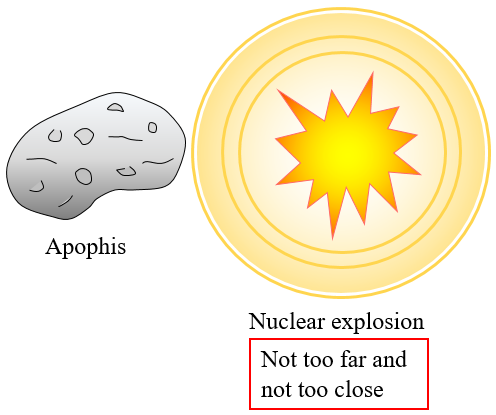
With this method, material on the asteroid surface facing the explosion is superheated due to the high level of irradiation. This superheated material vaporizes and "blows off" the asteroid surface due to rapid expansion, and produces temporary thrust that nudges the trajectory of the asteroid by a small but significant amount.
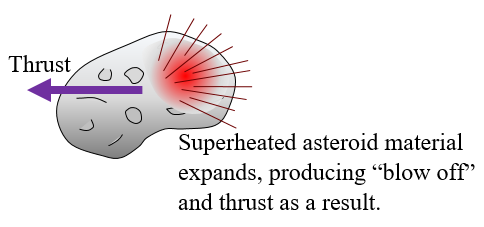
But this method must be done with great caution. The detonation must not be too far or too close from the asteroid. If it's too close, the asteroid can break up into smaller pieces making the impact scenario even worse. If the detonation is too far away, the effect will be too weak. The nuclear option might be the best option and can work on a time scale of a few years where a slight change in trajectory translates into a complete avoidance of collision. See reference: "Impact of neutron energy on asteroid deflection performance". https://www.sciencedirect.com/science/article/pii/S0094576521001028
To gain a sense of the destructive power of an asteroid impact, consider the meteor crater in Arizona which is 1.2 km across and 170 m deep. It was created by an asteroid 50 m across moving at about 12 km per second before impact.
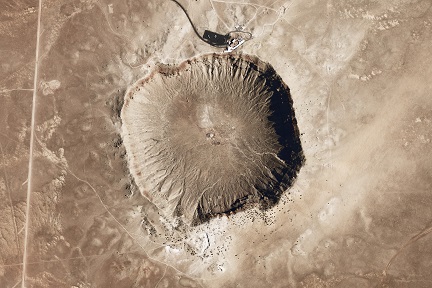
Apophis is 350 meters across and will be moving at 12 km per second. It will produce a bigger crater than the one in Arizona. If it strikes in the ocean it will produce a tsunami tens of meters high. This will flood coasts around the world, washing away infrastructure and killing millions. If it strikes land, the more likely scenario, it will produce a crater about 5 km wide and 1 km deep. The impact energy, about 3 × 1018 Joules, will generate a powerful airblast that will be felt everywhere on Earth, and will completely destroy buildings over an area of thousands of square kilometers. In either case, millions of lives are at risk. There could also be additional tectonic and climatic consequences from the impact.
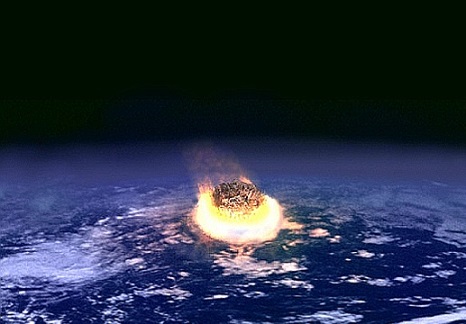
You can test out different impact scenarios using this simulation tool: https://impact.ese.ic.ac.uk/ImpactEarth/ImpactEffects/
The Apophis Planetary Defense Campaign (https://iopscience.iop.org/article/10.3847/PSJ/ac66eb) which took place in 2020-2021, showed that were an impact to occur, it would be somewhere in a swath over central Europe and Asia. Space agencies, such as ESA, in these areas would be wise to organize a mission to deflect it.
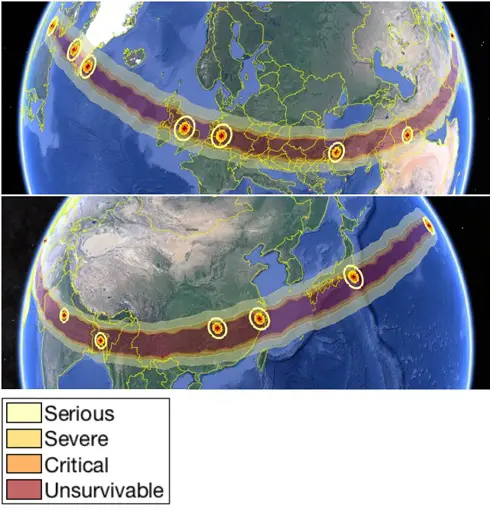
Scientists have accomplished many great things for the advancement of humanity. But they also have a dark side, such as creating nuclear bombs and playing dangerous games with science to satisfy their curiosity while also toying with our survival. But when it comes to Apophis, their failure may come from simply doing nothing.
We should not take chances with this. We should contact politicians and space agencies and urge them to deflect Apophis!
This page was last updated on May 18, 2023.
Additional reference:
https://www.space.com/asteroid-apophis-march-2021-flyby-science-preparations
Return to Physics Essays page
Return to Real World Physics Problems home page